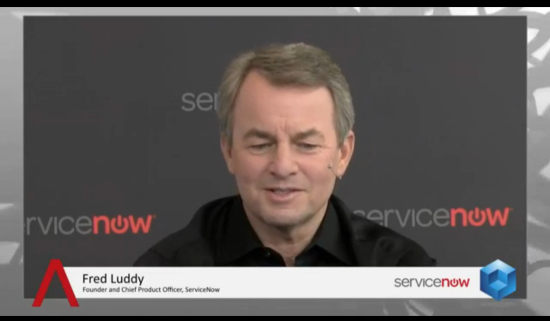 NEWS
NEWS
 NEWS
NEWS
 NEWS
NEWS
Fred Luddy, Founder and CPO at ServiceNow, discussed his long career as a programmer, his vision of services for business process management and technology trends with theCube co-hosts Jeff Frick and Dave Vellante, live at the ServiceNow Knowledge 2013 conference today.
![]()
SMAC as they are called (Social, Mobile, Analytics and Cloud), are here to stay, Fred Luddy said, but “the next thing that is going to add to that is the Internet of Things.” Tens of millions of things are expected to be interconnected on the planet by 2014/2015 – cameras, sensors, and other intertwined devices. “It’s going to be staggering when pretty much everything is connected,” he said, the main issue of this trend being privacy vs. freedom.
Talking about his career as a programmer, Luddy said that “when people are able to find a passion, a deep passion, that they are reasonably good at and they can make money, it’s almost unfair.” He wanted to write code since he was 17, and managed to fulfill his dream. “I love and hate technology,” he explained. He loves it when it’s enabling and helpful, but hates it when it makes him or someone else feel stupid, “that is why I focus on simplicity.”
Explaining where ServicesNow started as an idea, Luddy reacalled that when MyYahoo came out, 80,000 people customized it with absolutely no training. At the same time, using enterprise software took long training hours. He realized what was happening in the consumer space was simply amazing – easy to use apps, SMS alerts, etc, while the enterprise segment was stuck in a place where everything was boring. “My vision – 2003, November -was to be able to enable business people to create meaningful workflow applications.” The notion of the citizen developer is someone who’s not a developer, they take a platform like ServiceNow and create a meaningful application.
Dave Vellante pointed out that this vision was born during a period where the Internet Bubble had lead to serious questions about technology and its being a good return on investment. Luddy said that he started developing his platform on his laptop: it was just him, his laptop and a lot of coffee. He then showed the platform to other people, showing its capabilities but it was too “it can do anything.” So he had his team buid a set of applications that would create business value on top of the platform and he started with IT service management (ITSM). This marked ServiceNow’s debut into the Software-as-a-Service market.
Making the case for unified data management : software-led architecture
Asked why the notion of single system of record was important architecturally, Luddy said that “IT has a life cycle of things that they go through. They typically would manage individual pockets in individual spreadsheets, which would not be visible to management.” A single system of record is important because “now you can roll up the data to the CIO level.” There are CIOs with multiple million dollar budgets, they need to know where the funds need to go and if they are putting their company at risk through their investment. With ServiceNow “they have a clearer view of what is going on in the IT department.
“The way that large software companies try to solve stuff is to buy a lot and claim it is integrated,” when it’s really not, Luddy explained. The power of the central database gives freedom in what business processes are concerned. All the locations, all the people, the hierarchy, everything that’s actually involved in business processes is built into the ServiceNow system. “It is a purpose-built platform, it does workflow very well.”
Asked what’s next for the ServiceNow platform, Luddy mentioned aiming to enable any sort of interactions when business people request work or need information. “We want to be relevant to everybody in the business from this perspective.” To achieve this relevance, the company will build new applications to reach further and further. At this time, he pointed, the most common workflow engine is still email, and according to Luddy that’s a very poor choice.
Support our mission to keep content open and free by engaging with theCUBE community. Join theCUBE’s Alumni Trust Network, where technology leaders connect, share intelligence and create opportunities.
Founded by tech visionaries John Furrier and Dave Vellante, SiliconANGLE Media has built a dynamic ecosystem of industry-leading digital media brands that reach 15+ million elite tech professionals. Our new proprietary theCUBE AI Video Cloud is breaking ground in audience interaction, leveraging theCUBEai.com neural network to help technology companies make data-driven decisions and stay at the forefront of industry conversations.